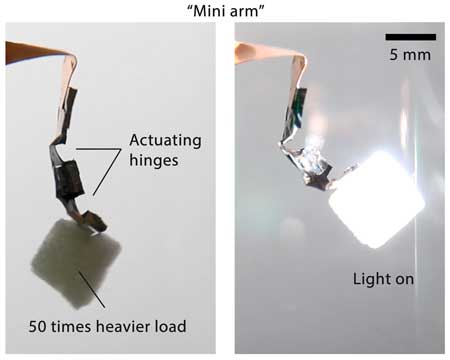| Jun 04, 2018 |
Future robots need no motors
|
|
(Nanowerk News) To develop micro- and biomimetic-robots, artificial muscles and medical devices, actuating materials that can reversibly change their volume under various stimuli are researched in the past thirty years to replace traditional bulky and heavy actuators including motors and pneumatic actuators.
|
|
A mechanical engineering team led by Professor Alfonso Ngan Hing-wan, Chair Professor in Materials Science and Engineering, and Kingboard Professor in Materials Engineering, Faculty of Engineering, the University of Hong Kong (HKU) published an article in Science Robotics ("Light-stimulated actuators based on nickel hydroxide-oxyhydroxide") that introduces a novel actuating material - nickel hydroxide-oxyhydroxide - that can be powered by visible (Vis) light, electricity, and other stimuli.
|
 |
| A mini arm with two actuating hinges lifting a weight 50 time heavier than itself under light.
|
|
The material actuation can be instantaneously triggered by Vis light to produce a fast deformation and exert a force equivalent to 3000 times of its own weight. The material cost of a typical actuator is as low as HKD 4 per cm2 and can be easily fabricated within three hours.
|
|
Among various stimuli, light-induced actuating materials are highly desirable because they enable wireless operation of robots. However, very few light driven materials are available in the past, and their material and production costs are high, which hinder their development in actual applications such as artificial muscles for robotics and human assist device, and minimally invasive surgical and diagnostic tools.
|
|
Developing actuating materials was identified as the top of the 10 challenges in "The grand challenges of Science Robotics".
|
|
Research in actuating materials can radically change the concept of robots which are now mainly motor-driven. Therefore, materials that can be actuated by wireless stimuli including a change in temperature, humidity, magnetic fields and light is one of the main research focus in recent years.
|
|
In particular, a material that can be actuated by Vis light and produces strong, quick and stable actuation has never been achieved. The novel actuating material system - nickel hydroxide-oxyhydroxide that can be actuated by Vis light at relatively low intensity to produce high stress and speed comparable to mammalian skeletal muscles has been developed in this research initiated by engineers in HKU.
|
|
In addition to its Vis light actuation properties, this novel material system can also be actuated by electricity, enabling it to be integrated into the present well-developed robotics technology. It is also responsive to heat and humidity changes so that they might potentially be applied in autonomous machines that harness the tiny energy change in the environment. Because the major component is nickel, the material cost is low.
|
|
The fabrication only involves electrodeposition which is a simple process, and the time required for the fabrication is around three hours, therefore the material can be easily scaled up and manufactured in industry.
|
|
The newly invented nickel hydroxide-oxyhydroxide responses to light almost instantaneously and produces a force corresponding to about 3000 times of its own weight.
|

